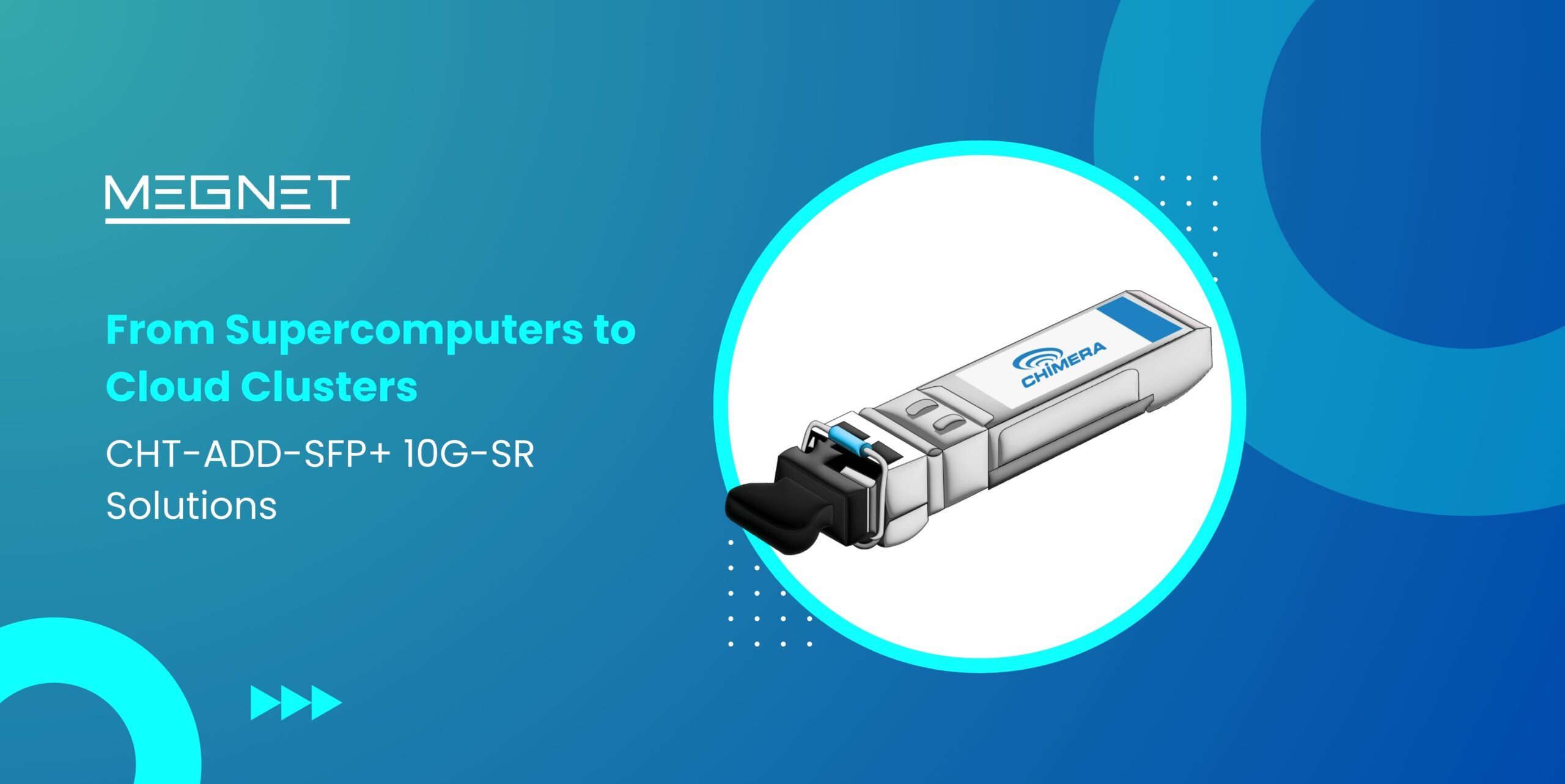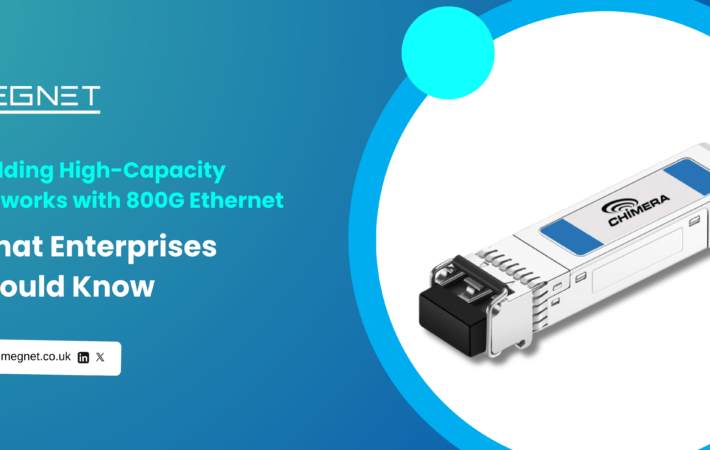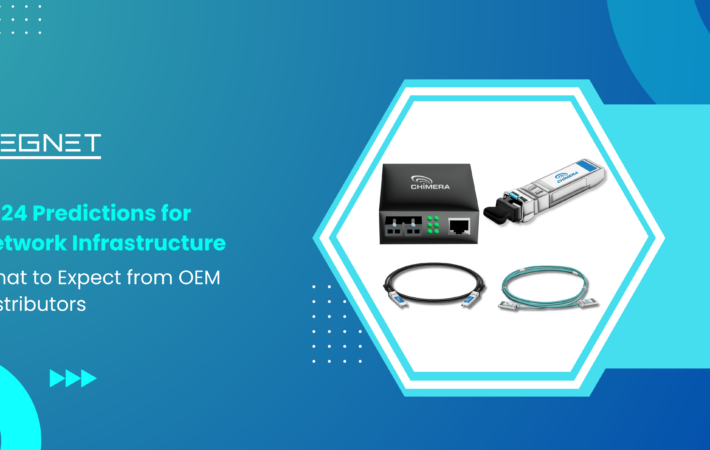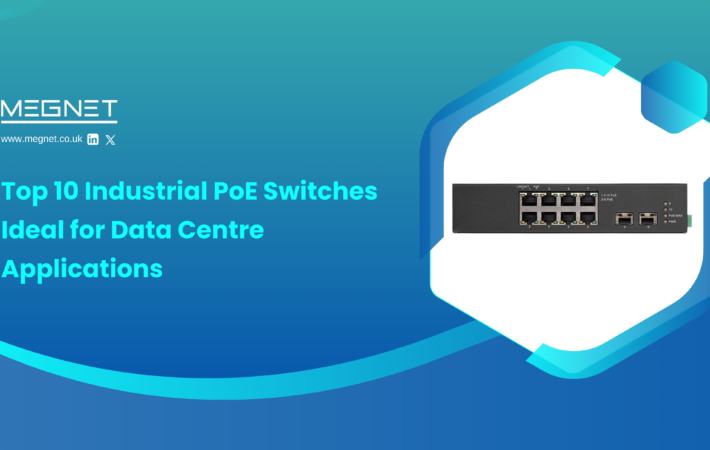
In the World of Bits and Bytes, CHT-ADD-SFP+ – 10G-SR Takes Centre Stage
The CHT-ADD-SFP+-10G-SR SFP+ transceiver sits at the intersection of several key industry trends driving the demand for high-performance and adaptable network solutions. Here’s a deeper dive into these trends and how the CHT-ADD-SFP+-10G-SR plays a role:
- Proliferation of 10 Gigabit Ethernet (10GbE):
The ever-increasing volume of data creation and transfer needs faster network speeds. 10GbE offers a significant leap from traditional Gigabit Ethernet (GbE), enabling faster data processing and transmission. The CHT-ADD-SFP+-10G-SR caters to this need by providing a cost-effective and reliable solution for deploying 10GbE connectivity over short distances.
- Growth of High-Performance Computing (HPC):
HPC applications are becoming increasingly sophisticated, demanding ever-greater processing power and data transfer speeds. The CHT-ADD-SFP+-10G-SR is perfectly suited for HPC environments, easing the rapid exchange of data between compute nodes and storage systems. This translates to faster simulations, modelling, and overall improved efficiency for HPC workloads.
- Advancements in Cloud Computing and Data Centres:
The widespread adoption of cloud-based services and applications needs robust and scalable data centre infrastructure. The CHT-ADD-SFP+-10G-SR can be deployed within data centres to connect cloud servers and storage devices, enabling faster data access for cloud services. This translates to improved performance and responsiveness for cloud users.
- Rise of Edge Computing and Internet of Things (IoT):
The growth of edge computing and IoT devices needs reliable and efficient data transfer between devices and centralized processing units. The CHT-ADD-SFP+-10G-SR can be an asset in these deployments, connecting edge devices like sensors and controllers to core networks. This ensures fast and reliable data transmission for real-time processing and analysis at the edge.
- Increasing Focus on Bandwidth-Intensive Applications:
Beyond the trends, several specific applications are driving the demand for high-bandwidth connectivity:
Video Streaming: The popularity of high-definition and 4K video streaming requires robust networks to handle large video files without lag or buffering. The CHT-ADD-SFP+-10G-SR eases smooth video transmission, ensuring a high-quality viewing experience.
Virtual Reality (VR) and Augmented Reality (AR): VR and AR applications generate and send substantial amounts of data. The CHT-ADD-SFP+-10G-SR can support these demanding applications by providing the necessary bandwidth for a seamless user experience.
Artificial Intelligence (AI) and Machine Learning (ML): AI and ML algorithms often require processing massive datasets. The CHT-ADD-SFP+-10G-SR can accelerate data transfer for training and running AI/ML models, leading to faster development cycles and improved performance.
Beyond the Core: Additional Applications for CHT-ADD-SFP+ -10G-SR
While the core applications lie in high-performance data centre environments and emerging technologies, the CHT-ADD-SFP+-10G-SR can also be beneficial in:
- Enterprise Network Upgrades: Businesses looking to modernize their network infrastructure to support bandwidth-intensive applications like video conferencing and large file transfers can use the CHT-ADD-SFP+-10G-SR for a cost-effective upgrade.
- Medical Imaging: Hospitals and medical facilities often deal with large medical images like MRIs and CT scans. The CHT-ADD-SFP+-10G-SR can ensure fast and reliable transfer of these images for diagnostics and consultations.
- Government and Public Institutions: Government agencies and public institutions can receive help from the CHT-ADD-SFP+-10G-SR for high-speed data transfer between offices and data centres.
Let’s Deep Dive into CHT-ADD-SFP+-10G-SR: Technical Specifications and Considerations
While we’ve explored the applications of the CHT-ADD-SFP+-10G-SR SFP+ transceiver, a deeper understanding needs a look into its technical specifications and deployment considerations.
Technical Specifications:
- Form Factor: SFP+ (Small Form-factor Pluggable Plus)
- Data Rate: 10 Gigabit Ethernet (10GbE)
- Wavelength: 850nm (nanometres)
- Distance: Up to 300 metres (984 feet) on multimode fibre optic cable (OM1, OM2, or equivalent)
- Interface: Electrical (electrical interface with network device) and Optical (optical interface for fibre connection)
- Connector: LC (Lucent Connector) duplex – two connectors for transmitting and receiving data
- Power Consumption: Typically, less than 1.5 watts
- Operating Temperature: 0°C to 70°C (32°F to 158°F)
- Compliance: Meets SFP+ MSA (Multi-Source Agreement) standards for interoperability
- Compatibility: Ensure the CHT-ADD-SFP+-10G-SR is compatible with your network switch or router model. Consult your device’s documentation or the transceiver manufacturer for compatibility information.
- Fibre Optic Cable: The CHT-ADD-SFP+-10G-SR is designed for use with multimode fibre optic cables. Choose the right cable type (OM1, OM2, etc.) based on your desired reach (distance) and ensure proper cable quality for reliable performance.
- Cleaning: Regularly clean the LC connector tips on the transceiver and fibre cable with dust wipes or compressed air to prevent dust buildup and signal degradation.
- Safety: Always follow safety precautions when working with fibre optic cables. Avoid looking directly into the fibre optic connector tip, as the laser light can damage your eyes.
Additional Considerations:
Single-Mode vs Multimode Fibre: While the CHT-ADD-SFP+-10G-SR is perfected for multimode fibre for short distances, SFP+ transceivers are also available for single-mode fibre deployments that require longer reach (up to several kilometres).
Advanced Features: Some SFP+ transceivers offer advanced features like Digital Diagnostics Monitoring (DDM) capabilities that enable real-time monitoring of transceiver performance parameters like temperature and laser output power.
By understanding these technical specifications and deployment considerations, you can ensure the CHT-ADD-SFP+-10G-SR transceiver is properly integrated into your network infrastructure for best performance and reliability.

Some Advanced Technical Details of CHT-ADD-SFP+-10G-SR
Beyond the core technical specifications, the CHT-ADD-SFP+-10G-SR SFP+ transceiver boasts added features and functionalities worth exploring for a comprehensive understanding:
- Laser Characteristics:
- Laser Type: Vertical-cavity surface-emitting laser (VCSEL) – known for reliability and lower power consumption compared to edge-emitting lasers (EELs) commonly used in single-mode SFP+ transceivers.
- Wavelength Tolerance: Typically, within ±5nm of the centre wavelength (850nm) to ensure compatibility with multimode fibre optic cable specifications.
- Maximum Output Power: The exact power output may vary depending on the specific model but typically falls within the range specified by SFP+ MSA standards for eye safety.
- Electro-Optical Specifications:
- Data Encoding: 10GBASE-SR – This refers to the specific encoding scheme used to convert electrical data into optical pulses for transmission over fibre optic cable.
- Minimum Receive Sensitivity: The minimum optical power level needed at the receiver for error-free data reception. Lower sensitivity shows better receiver performance.
- Maximum Transmit Power: The maximum optical power level transmitted by the laser source. This is regulated by standards to prevent eye safety hazards.
- Extinction Ratio: The ratio of optical power between the “on” and “off” states of the laser, affecting signal quality and overall data transmission performance.
- Dispersion Tolerance:
- Chromatic Dispersion (CD): The amount of signal distortion caused by different wavelengths of light traveling at slightly different speeds within the fibre optic cable. The CHT-ADD-SFP+-10G-SR is designed to run within the dispersion limitations of multimode fibre for short-distance applications.
- Modal Dispersion: The spreading of light pulses due to different propagation modes within multimode fibre. The chosen multimode fibre type (OM1, OM2, etc.) should be proper for the desired reach to minimize modal dispersion effects.
- Diagnostics Monitoring (Optional):
Some CHT-ADD-SFP+-10G-SR models may support DDM (Digital Diagnostics Monitoring) capabilities. This allows the network device to check real-time operational parameters of the transceiver, including:
- Temperature
- Laser bias current
- Laser output power
- Received optical power
- Voltage supply levels
- Monitoring these parameters helps with proactive maintenance and troubleshooting potential issues with the transceiver.
- Regulatory Compliance:
The CHT-ADD-SFP+-10G-SR should follow relevant industry standards for safety and interoperability:
- SFP+ MSA (Multi-Source Agreement): Ensures compatibility with various SFP+ compliant network devices.
- RoHS (Restriction of Hazardous Substances): Restricts the use of certain hazardous materials in electronic equipment.
- Laser Safety Standards: Conforms to regulations like IEC 60825-1 for eye safety from laser radiation.
By considering these advanced technical details, you can gain a deeper understanding of the CHT-ADD-SFP+-10G-SR’s capabilities and limitations. This knowledge can be valuable for selecting the right transceiver for your specific network requirements and ensuring best performance within your network infrastructure. Remember, consulting the transceiver’s datasheet or manufacturer specifications will provide the most detailed and up-to-date technical information.
Optimising Performance of CHT-ADD-SFP+-10G-SR Deployment
We’ve covered the technical specifications and advanced details of the CHT-ADD-SFP+-10G-SR SFP+ transceiver. Now, let’s explore some added considerations to perfect performance and ensure a smooth deployment:
- Quality Matters:
Choose reputable SFP+ transceiver vendors: opt for vendors known for high-quality components and rigorous testing procedures. This ensures reliable performance and minimizes the risk of compatibility issues or early transceiver failures.
Beware of counterfeit transceivers: Counterfeit transceivers may not meet industry standards and could lead to network instability, performance degradation, or even damage to network equipment. Stick to reputable vendors and authorized distributors.
- Environmental Factors:
Temperature: Keep the ambient operating temperature within the specified range (typically 0°C to 70°C) for best transceiver performance and lifespan. Avoid excessive heat sources or locations with poor ventilation.
Airflow: Ensure proper airflow around network devices to prevent overheating, which can affect transceiver performance and overall network stability.
Humidity: Keep moderate humidity levels to avoid condensation on the transceiver’s optical connector, potentially leading to signal degradation.
- Cable Management:
Minimize cable bends: Avoid sharp bends in fibre optic cables, as this can increase signal attenuation and impact performance. Maintain recommended bend radius specifications for the specific multimode fibre cable type being used.
Secure cable connections: Ensure fibre optic cables are securely plugged into the transceiver and network device to prevent accidental disconnections or signal integrity issues. Consider using dust caps on unused SFP+ ports to protect them from dust and debris.
Cable Labelling: Clearly label fibre optic cables to find connected devices and avoid confusion during maintenance or troubleshooting.
- Network Monitoring:
Utilize network monitoring tools to proactively find potential issues with the transceiver or overall network performance. Monitor parameters like signal quality, temperature, and bit error rate (BER) to find any anomalies requiring attention.
Firmware Updates: Some SFP+ transceivers may offer firmware update capabilities. Check with the transceiver vendor for available firmware updates and follow recommended update procedures to ensure compatibility and potential performance improvements.
Beyond the Basics: Exploring Advanced Applications for CHT-ADD-SFP+-10G-SR
While the CHT-ADD-SFP+-10G-SR excels in core applications like data centres and High-Performance Computing (HPC), its versatility extends beyond these established use cases.

Cloud computing
Here’s a glimpse into some exciting and emerging applications where the CHT-ADD-SFP+-10G-SR can play a significant role:
- Industrial Automation and Smart Factories:
The rise of Industry 4.0 and smart factories demands robust and reliable data transfer between industrial machines, sensors, and control systems. The CHT-ADD-SFP+-10G-SR can ease the real-time transmission of substantial amounts of data generated by industrial processes, enabling faster decision-making, improved operational efficiency, and predictive maintenance capabilities.
- Intelligent Transportation Systems (ITS):
Modern transportation systems are increasingly reliant on data to perfect traffic flow, manage congestion, and improve safety. The CHT-ADD-SFP+-10G-SR can connect traffic cameras, sensors, and communication devices, enabling real-time data collection and analysis for better traffic management and improved public transportation experiences.
- 5G Network Infrastructure:
The rollout of 5G mobile networks needs high-bandwidth connectivity for backhaul connections that aggregate data traffic from cell towers to core networks. The CHT-ADD-SFP+-10G-SR can be deployed within the backhaul infrastructure to support the high data rates and low latency needed for 5G applications like mobile broadband and internet of things (IoT) connectivity.
- Medical Imaging and Telemedicine:
The transmission of large medical images like MRIs and CT scans requires high-speed and reliable connections. The CHT-ADD-SFP+-10G-SR can ease the rapid transfer of these images between medical facilities, enabling faster diagnoses, remote consultations, and improved patient care.
- Surveillance and Security Systems:
High-definition security cameras generate substantial amounts of video data. The CHT-ADD-SFP+-10G-SR can be used to connect security cameras to recording systems and checking centres, enabling real-time video transmission for enhanced security and surveillance applications.
The CHT-ADD-SFP+-10G-SR SFP+ transceiver is a versatile and powerful solution for a wide range of network applications. Its combination of high bandwidth, low latency, multimode fibre compatibility, and cost-effectiveness makes it an ideal choice for businesses and organizations looking to upgrade their network infrastructure and unleash their true potential. Whether you’re managing demanding HPC workloads, delivering high-quality video streams, or easing seamless cloud operations, the CHT-ADD-SFP+-10G-SR can provide the reliable and high-performance connectivity you need to thrive in today’s data-driven world.
FAQ's
High-bandwidth (10GbE) for demanding applications, Cost-effective solution for short-distance fiber optic connections, Easy to install and use with hot-swappable functionality.
Data centers, cloud computing, video streaming, business LAN upgrades, edge computing, and more.
It works with multimode fiber optic cables (OM1, OM2, or equivalent) for up to 300 meters.
Ensure compatibility by checking your switch model's documentation or contacting the transceiver manufacturer.
Choose high-quality transceivers and fiber optic cables, Maintain proper operating temperature and airflow for optimal performance, Utilise network monitoring tools to identify potential issues.
Yes, it support features like Digital Diagnostics Monitoring (DDM) for real-time performance monitoring.
Yes, other SFP+ transceivers exist with different data rates, cable compatibility (single-mode fiber), or extended reach capabilities. Contact us to know more.








Leave a comment
Your email address will not be published. Required fields are marked *